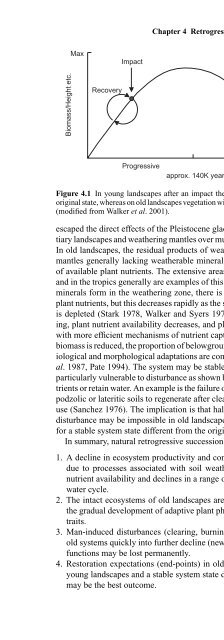Linking Restoration and Ecological Succession (Springer ... - Inecol
Linking Restoration and Ecological Succession (Springer ... - Inecol
Linking Restoration and Ecological Succession (Springer ... - Inecol
You also want an ePaper? Increase the reach of your titles
YUMPU automatically turns print PDFs into web optimized ePapers that Google loves.
Biomass/Height etc.<br />
Max<br />
Recovery<br />
Impact<br />
Chapter 4 Retrogressive <strong>Succession</strong> <strong>and</strong> <strong>Restoration</strong> on Old L<strong>and</strong>scapes 71<br />
Impact<br />
Progressive Regressive<br />
approx. 140K years<br />
Partial recovery<br />
or collapse<br />
Figure 4.1 In young l<strong>and</strong>scapes after an impact the vegetation tends to return to the<br />
original state, whereas on old l<strong>and</strong>scapes vegetation will only partially recover or collapse<br />
(modified from Walker et al. 2001).<br />
escaped the direct effects of the Pleistocene glaciations that destroyed the Tertiary<br />
l<strong>and</strong>scapes <strong>and</strong> weathering mantles over much of the northern hemisphere.<br />
In old l<strong>and</strong>scapes, the residual products of weathering have formed thick soil<br />
mantles generally lacking weatherable minerals <strong>and</strong> have low concentrations<br />
of available plant nutrients. The extensive areas of lateritic soils in Australia,<br />
<strong>and</strong> in the tropics generally are examples of this (Sanchez 1976). As secondary<br />
minerals form in the weathering zone, there is an initial increase in available<br />
plant nutrients, but this decreases rapidly as the supply of weatherable minerals<br />
is depleted (Stark 1978, Walker <strong>and</strong> Syers 1976). With progressive weathering,<br />
plant nutrient availability decreases, <strong>and</strong> plant species trend toward those<br />
with more efficient mechanisms of nutrient capture <strong>and</strong> storage. Aboveground<br />
biomass is reduced, the proportion of belowground biomass increases <strong>and</strong> physiological<br />
<strong>and</strong> morphological adaptations are common (Lamont 1981, Walker et<br />
al. 1987, Pate 1994). The system may be stable in its undisturbed state, but is<br />
particularly vulnerable to disturbance as shown by a lesser ability to recycle nutrients<br />
or retain water. An example is the failure of tropical rainforests on yellow<br />
podzolic or lateritic soils to regenerate after clearing, burning, <strong>and</strong> agricultural<br />
use (Sanchez 1976). The implication is that halting an inevitable decline after<br />
disturbance may be impossible in old l<strong>and</strong>scapes, <strong>and</strong> at best one has to settle<br />
for a stable system state different from the original as a restoration end-point.<br />
In summary, natural retrogressive succession has the following attributes:<br />
1. A decline in ecosystem productivity <strong>and</strong> complexity occurs over millennia<br />
due to processes associated with soil weathering, especially a decline in<br />
nutrient availability <strong>and</strong> declines in a range of soil properties that affect the<br />
water cycle.<br />
2. The intact ecosystems of old l<strong>and</strong>scapes are usually stable as the result of<br />
the gradual development of adaptive plant physiological <strong>and</strong> morphological<br />
traits.<br />
3. Man-induced disturbances (clearing, burning, grazing, <strong>and</strong> farming) push<br />
old systems quickly into further decline (new system states) <strong>and</strong> key system<br />
functions may be lost permanently.<br />
4. <strong>Restoration</strong> expectations (end-points) in old l<strong>and</strong>scapes are different from<br />
young l<strong>and</strong>scapes <strong>and</strong> a stable system state different from the original state<br />
may be the best outcome.

















